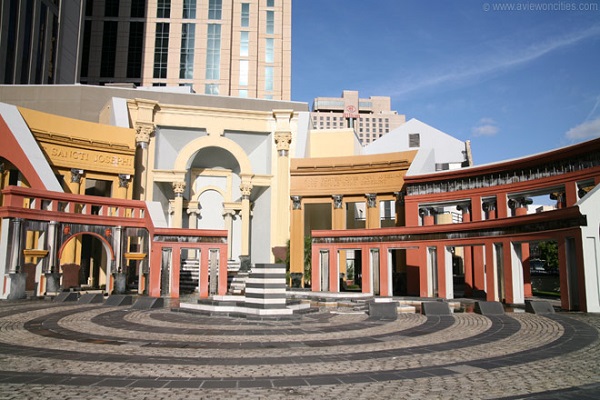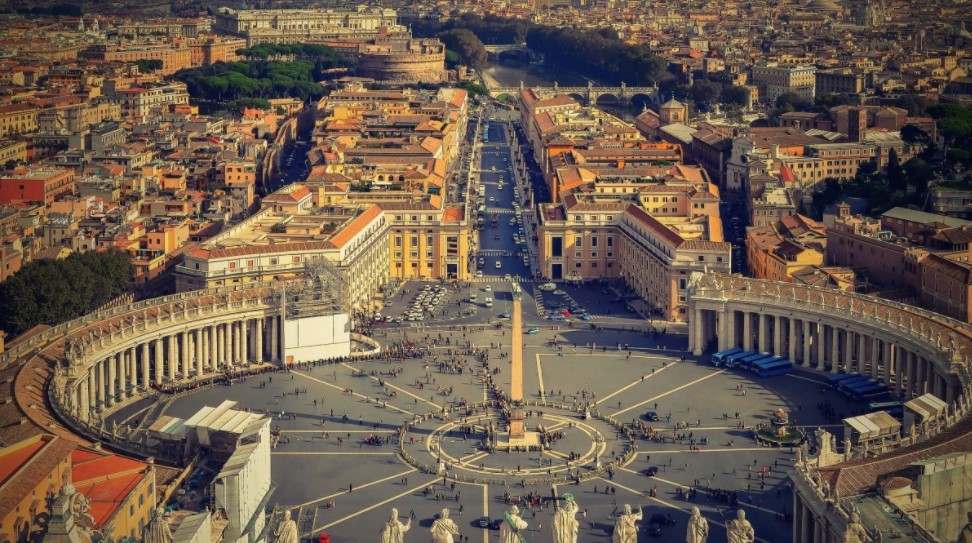Piazza
Contents |
[edit] Introduction
The term piazza typically refers to an open space, usually rectangular, surrounded by buildings.
A piazza is often a public square (although it is not always square). They are usually covered with a hard surface, but are not generally open to motor vehicle traffic. They may be suitable for open markets and social gatherings - both informal and official. People often consider the piazza as a place to conduct personal business or just gather to experience spontaneous conviviality over a cup of coffee or during a weekly stroll. Important religious and municipal buildings are frequently located in the piazza, which may also feature cafes, bars and shops.
[edit] History
The piazza has existed in some form for thousands of years. In ancient Roman times, it was the main square of the community and it served as the geometric centre of the city.
This changed in medieval times, when cities grew around defensive structures and within walls. Piazzas were seen as dangerous places, since they could leave groups of people vulnerable to attack (or they could serve as gathering places for those looking to stir up rebellion).
[edit] The age of the Italian piazza
In Renaissance times, the piazza regained its prominence, serving as the central gathering point in many Italian cities. During the 1800s, some served as open air settings for entertainment.
The Piazza San Pietro (or St Peter’s Square) in the Vatican is one of the most famous piazzas in the world. Situated in front of St Peter’s Basilica, it was designed in the 1600s by Gian Lorenzo Bernini. The centrally paved area is round rather than square and is flanked by gigantic columns.
[edit] Alternative meanings of piazza
In 17th and 18th century England, the term piazza developed a second meaning, describing a long covered walk or loggia with a roof supported by columns.
In the 19th century in the US 'piazza' was used to describe a veranda created by eaves projecting from a building.
[edit] Related articles on Designing Buildings Wiki
Featured articles and news
Latest Build UK Building Safety Regime explainer published
Key elements in one short, now updated document.
UKGBC launch the UK Climate Resilience Roadmap
First guidance of its kind on direct climate impacts for the built environment and how it can adapt.
CLC Health, Safety and Wellbeing Strategy 2025
Launched by the Minister for Industry to look at fatalities on site, improving mental health and other issues.
One of the most impressive Victorian architects. Book review.
Common Assessment Standard now with building safety
New CAS update now includes mandatory building safety questions.
RTPI leader to become new CIOB Chief Executive Officer
Dr Victoria Hills MRTPI, FICE to take over after Caroline Gumble’s departure.
Social and affordable housing, a long term plan for delivery
The “Delivering a Decade of Renewal for Social and Affordable Housing” strategy sets out future path.
A change to adoptive architecture
Effects of global weather warming on architectural detailing, material choice and human interaction.
The proposed publicly owned and backed subsidiary of Homes England, to facilitate new homes.
How big is the problem and what can we do to mitigate the effects?
Overheating guidance and tools for building designers
A number of cool guides to help with the heat.
The UK's Modern Industrial Strategy: A 10 year plan
Previous consultation criticism, current key elements and general support with some persisting reservations.
Building Safety Regulator reforms
New roles, new staff and a new fast track service pave the way for a single construction regulator.
Architectural Technologist CPDs and Communications
CIAT CPD… and how you can do it!
Cooling centres and cool spaces
Managing extreme heat in cities by directing the public to places for heat stress relief and water sources.
Winter gardens: A brief history and warm variations
Extending the season with glass in different forms and terms.
Restoring Great Yarmouth's Winter Gardens
Transforming one of the least sustainable constructions imaginable.
























